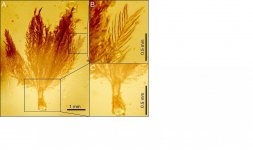Fred Ruhe
Well-known member

Arindam Roy, Case V. Miller, Michael Pittman, Thomas G. Kaye, Adolf Peretti, 2020
Three-dimensionally preserved ‘Stage IIIb’ fossil down feather supports
developmental modularity in feather evolution
bioRxiv 2020.08.26.268060 (preprint)
doi: https://doi.org/10.1101/2020.08.26.268060
https://www.biorxiv.org/content/10.1101/2020.08.26.268060v1
Free pdf: https://www.biorxiv.org/content/10.1101/2020.08.26.268060v1.full.pdf
Abstract
We describe a unique three-dimensionally preserved fossil down feather from the Late Cretaceous of Myanmar. It’s morphology is highly congruent with Stage IIIb of the widely accepted Prum and Brush model of feather evolution-development. This makes the new specimen the first evidence of this developmental stage in the fossil record. The Stage IIIb diagnosis is robustly supported by the absence of a central rachis and by its paired barbules emanating from radially positioned barbs that are attached to a short calamus. Prum and Brush’s model hypothesises a bifurcation in the evolution-development pathway at Stage III. Stage IIIa involves rachis development and branching into barbs. Stage IIIb involves branching of the barbs from the calamus and then further branching of the barbules from the barbs. These two pathways then converge into Stage IIIa+b where feathers produce a rachis, barbs and barbules in nested order, finally leading to Stage IV. Evolution-development studies on the morphogenesis of feathers have unequivocally shown that such feather branching can be controlled by BMP, Noggin, Shh and several other proteins. Therefore, molecular crosstalk can convert a barb into a rachis and vice versa. The topology of this down feather, consistent with specific patterns of modular protein-protein signalling already observed, provides the first definitive evidence that such signalling was responsible for the evolution of a diverse inventory of feather morphologies in non-avialan dinosaurs and early birds since the middle Jurassic.
Enjoy,
Fred
Three-dimensionally preserved ‘Stage IIIb’ fossil down feather supports
developmental modularity in feather evolution
bioRxiv 2020.08.26.268060 (preprint)
doi: https://doi.org/10.1101/2020.08.26.268060
https://www.biorxiv.org/content/10.1101/2020.08.26.268060v1
Free pdf: https://www.biorxiv.org/content/10.1101/2020.08.26.268060v1.full.pdf
Abstract
We describe a unique three-dimensionally preserved fossil down feather from the Late Cretaceous of Myanmar. It’s morphology is highly congruent with Stage IIIb of the widely accepted Prum and Brush model of feather evolution-development. This makes the new specimen the first evidence of this developmental stage in the fossil record. The Stage IIIb diagnosis is robustly supported by the absence of a central rachis and by its paired barbules emanating from radially positioned barbs that are attached to a short calamus. Prum and Brush’s model hypothesises a bifurcation in the evolution-development pathway at Stage III. Stage IIIa involves rachis development and branching into barbs. Stage IIIb involves branching of the barbs from the calamus and then further branching of the barbules from the barbs. These two pathways then converge into Stage IIIa+b where feathers produce a rachis, barbs and barbules in nested order, finally leading to Stage IV. Evolution-development studies on the morphogenesis of feathers have unequivocally shown that such feather branching can be controlled by BMP, Noggin, Shh and several other proteins. Therefore, molecular crosstalk can convert a barb into a rachis and vice versa. The topology of this down feather, consistent with specific patterns of modular protein-protein signalling already observed, provides the first definitive evidence that such signalling was responsible for the evolution of a diverse inventory of feather morphologies in non-avialan dinosaurs and early birds since the middle Jurassic.
Enjoy,
Fred




